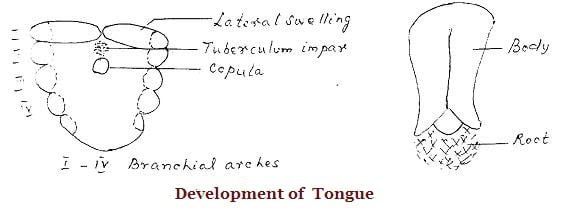TABLE OF CONTENTS
Development of Tongue of animals
The tongue of animals develops from the ventral ends of the branchial arches. It consists of two parts oral and pharyngeal.

The oral part is the body occupying the mouth cavity and arises from the mandibular arches in front of the oral membrane and hence is covered by ectodermal epithelium. It bears papillae and is concerned with mastication.
The pharyngeal part is the root, which develops from the second, third and fourth – arches and is covered by endodermal epithelium. It is concerned with swallowing.
The junction between ectoderm and endoderm is in front of the row of vallate pupillae whereas the body and root are demarcated by a V-shaped terminal sulcus behind them.
The body arises from three primodia – a median triangular tuberculum impar and a pair of lateral swellings from the first arch. At the same time the root arises from a median primordium – copula from the union of the base of second arches. Copula is encroached by the third and fourth arches.
Anomalies in development of tongue
Bifid tongue and Trifid tongue are the anomalies in development of tongue.

